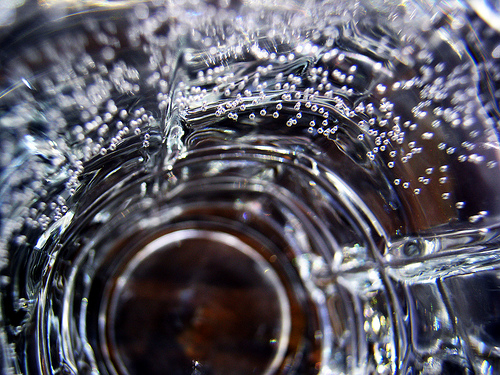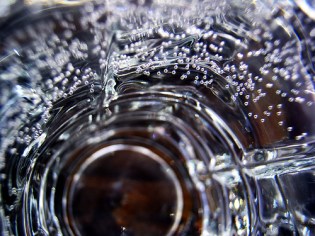Cross-posted from Gilt Taste.
I don’t want to sound too much like a soda jerk, but there’s something truly refreshing about making your own fizzy water. And if you’re going to make carbonated water at all, why not live deep, suck the marrow out of life, and clone your favorite top-shelf mineral water?
Here’s what you should know.
First off, since you’re going to be drinking a lot of homemade Gerolsteiner, you should probably pick up a keg to fill. If you’re not sure of how much you can handle, you can use an off-the-shelf gadget like iSi or SodaStream for starters, but they’ll only give you a liter at a time. Sooner or later, you’ll want to upgrade. (I’ll be honest. I only started this quest to find fountains and fountains of sparkling water because I happened to have three empty kegs that I needed to put something in.)
Two of my kegs came from my dad’s high school buddy, who, after years of serious home brewing and heavy drinking, discovered the miraculous power of AA, probably with a little prodding from the local brass. Dad’s a pharmacist and along with the kegs, he’s given me a certain reverence for early American druggists, who, lest we forget, dispensed phosphates and bicarbs along with carbonated, caffeinated colas. The other keg came from the local transfer station. There was some fuzzy syrup from somebody’s wedding in the bottom of that one, which brings me to the first step: Sanitize your container. (Note: Bleach corrodes a keg, so you might actually want to buy some off-the-shelf sanitizer).
If you’re working with kegs, go to the welding supply store and pick up a tank of CO2. “Kegerator?” The guy working will probably ask, especially if you happen to be a young dude and you are not wearing Dickies. Tell him no, you’re just really into drinking water.
While you’re there, pick up the requisite gas regulator and hoses, or head over to a home-brewing supply store for these. Presumably, though, you have the rest of what you need at home — an unlimited supply of delicious tap water. (Note: In Phoenix and some of the drier places in the country, carbonating and adding minerals to the water may not be enough to actually make the odd flavors of the water appealing, although New Yorkers love sparkling Chateau Bloomberg, drawn fresh from the Pepacton.)
Which brings us to the next step: Figure out what minerals you want in your water. It really helps if you have a favorite brand of mineral water to copy. Martin Lersch of the blog Khymos created a series of Excel spreadsheets that shows the contents of some classic European specimens. Yes, you can to steal the recipe for Perrier. It has 390 milligrams of sodium bicarbonate per liter.
Next, find out what’s in your tap water. If you drink municipal water, chances are the public utility has done your dirty work and you can find a recent chemical analysis from the water department. Tap water tends to have a little bit of chloride, some sodium, and a minuscule amount of calcium. For my kegs, I did the math and subtracted these salts from the recipe for Gerolsteiner, the classic German bubbly, and added in the other minerals. My recipe amounted to a dash of table salt, two dashes of Epsom salt (found in health food stores), a heaping teaspoon of pickling lime (found at farm supply stores and as “Cal” at the Mexican grocery), and less than a half teaspoon of baking soda and milk of magnesia (found in the laxative section of drugstores).
For those of you with triple beams at home, that’s 0.5g NaCl, 1g MgSO4, 6.4g Ca(OH)2, 3.1g of NaHCO3, and 2.3 g Mg(OH)2.
I pray for you sinners who slept though math class in high school and any Americans out there who still have an aversion to the metric system, but until someone develops the app you’re going to have to sit down and do some calculations — and those, frankly, are a lot easier to do in grams and liters. You’ll find that even with a 19-liter keg, the quantity of minerals you’re adding is almost immeasurably small. These quantities get even smaller with an 850-mL home carbonation system. The easiest way around this is to make a concentrated mineral water “stock,” a kind of liquid bouillon. Dissolve 10 liters’ worth of the mineral mixture with 100 mL of water and, for every liter of water you make, add 10 mL of the concentrated solution.
I should tell you that the water will look milky and taste like cement at this point, heavy and kind of dull, until you carbonate it, which will dissolve those minerals, clarify the water and lighten the flavor and texture. How fizzy you want it is up to you. At 30 pounds of pressure, it’s refreshing, but nothing like the throat-ripping satisfaction of real seltzer or ice-cold European mineral water. I like it molto frizzante, you know? I filled the keg with water, closed the lid, pumped in 60 psi, and rocked it back and forth on the kitchen floor to mix it. (Note: It’s also fun to pretend you’re a lumberjack here, using the keg instead of a log rolling down a river. Note too: This is only fun until the keg shoots out from under your feet.)
The final variable is how to store and serve the water. Since there’s an inverse relationship between the water temperature and the amount of soluble carbon dioxide, cold bubbly is the way to go. If you’ve ever had a warm Coke, you know there’s a lot of foam and not a lot of fizzy bite. So actually, a Kegerator isn’t a terrible idea. (Just don’t tell the welding shop guy you’re buying a Kegerator for water; you’ll break his heart.) If you don’t decide to go that far, you can always fill bottles with homemade sparkling water, seal them, and chill them in the refrigerator. And now you’re ready to discover the fine line between ahh and ahhhhhh!





